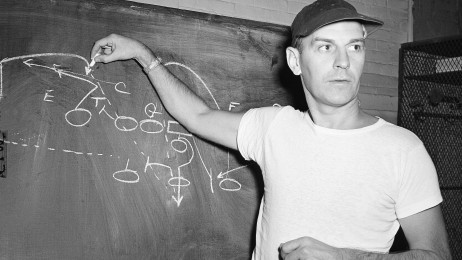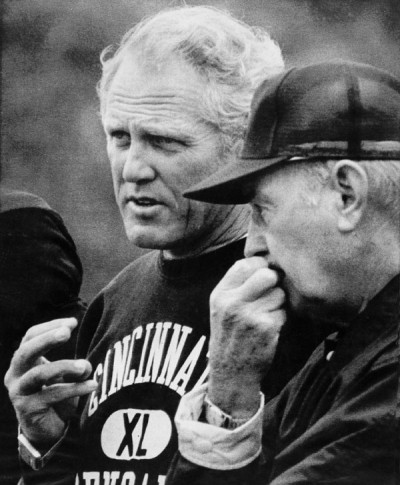He is the architect of the modern game of pro football, a true innovator who introduced many things into the game that are commonplace today. Our NFL 100 honored man today is Paul Brown, founder and head coach of the Cleveland Browns franchise in the All America Conference in the 1940s. His Cleveland teams won the AAFC Championship in all 4 seasons of the league’s existence, and when that league folded and they merged with the NFL, they proceeded to upset the Los Angeles Rams to capture the established league’s title. Brown’s innovations were both plentiful and ahead of their time. He invented the draw play, introduced classroom training and film study, and was the first to hire a full staff of assistant coaches. Also, he invented the first face mask, the practice squad, was instrumental in breaking football’s color barrier and was the first to call plays from the sideline to his quarterback through the use of “messenger guards”. He was also a tremendous innovator when it came to a franchise being organized and professional. He developed pass patterns that were designed to take advantage of weaknesses in a defense, held strictly timed practice sessions that included on-field practice and classroom study. He is credited with being the first coach to create the “passer’s pocket”, where the offensive line was strategically positioned to give the quarterback more time to find open receivers. He put together an organized system within the administration for scouting college talent, emphasizing the need to find intelligent players who could absorb his play book.

Paul Brown, classroom instructor
Brown’s organized ways would eventually lead to his undoing in Cleveland. He was not only organized but very strict and rigid in dealing with players. He was terse, would humiliate players in film sessions when they made mistakes, didn’t allow drinking or smoking and had a rule that prohibited players from having sex after Tuesday each week during the season. He was a miser when it came to negotiating contracts, and even refused to cede any authority to team owner Art Modell. By 1962 both Modell and the players had become disenchanted with Brown’s refusal to change with the times, and following the 1962 season Modell fired him and elevated Blanton Collier to the head coaching position. Collier wound up winning an NFL title in 1964, so Brown’s removal was vindicated. He missed being out of the game, however, so when the opportunity to build another team from scratch became available when the AFL decided to put an expansion franchise in Cincinnati, Brown became its’ founder. His stubborn ways still came out, though. He originally didn’t want to be involved in the Bengals’ franchise because they were to be part of the AFL, what he considered an inferior product. The merger with the 2 leagues meant that eventually the Cincinnati team would be in the newly structured NFL, so Brown came on board. It’s pretty much accepted that Brown chose almost exactly the same color orange as the Browns’ color for the Bengals as a tweak towards Modell. In the early years after the merger, when the two franchises became division rivals, it was hard to discern which team was which when they played each other. The innovations continued in Cincinnati. When star quarterback Greg Cook was injured, the Bengals turned to their backup, Virgil Carter, to lead the team. Carter’s arm strength was limited, so Brown and assistant coach Bill Walsh developed a short passing attack that would become the “West Coast” offense Walsh would use to great success years later with the San Francisco 49ers. Brown retired from coaching in 1975 but remained the Bengals’ team president, a role his son Mike took over, and still holds, upon Brown’s death in 1991. The legendary coach and innovator was honored with an induction into the Pro Football Hall of Fame in 1967.

Paul Brown and protégé Bill Walsh